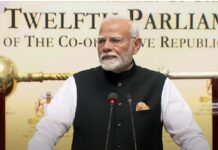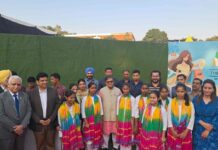Division of Rheumatology, Department of Internal Medicine, PGIMER observes Rheumatoid Arthritis day’
Rheumatoid arthritis, also called as ‘gathiya’ or ‘bai’ in common colloquial use in India, is an inflammatory arthritis that affects the joints of the body like the finger joints, wrist joints, elbow joints, knee joints, ankles and toe joints. It is important to first clarify that it is different from ‘knee osteoarthritis’ or knee pain which comes in old age due to the overuse of knee joint and will affect most of us eventually as we grow older. On the other hand, rheumatoid arthritis is different – it is found in only 0.5-1 percent of the Indian population, and comes mostly in a younger age group, typically in the 20-40 years (but no age is exempt) and is more in women (almost three times more common). In fact, in many women it starts just after they deliver babies! It is characterized by pain and swelling of joints and is characterized by stiffness of the joints after rest, most prominent after night sleep in the morning, which usually lasts from 30 minutes to many hours before the patient feels normal.
The major issue that we face is the lack of recognition of this arthritis both by patients themselves, patient families, and even general practioners. This leads to patients with such complaints being characterized as ‘lazy’ or ‘not wanting to work’ rather than understanding their problem. Also, most people wrongly think it is due to calcium deficiency and keep taking calcium tablets. It is important that such patients be seen at least once by trained doctors (physicians not orthopedicians) who deal with and have experience in the diagnosis and treatment of arthritis – these doctors are called rheumatologists. It is important to emphasize that many patients of rheumatoid arthritis can be rheumatoid factor (colloquially called ‘RA factor’) and CCP factor (another test for this disease) negative, and often the diagnosis can only be made by experience by a rheumatologist. Unfortunately, rheumatologists are available only in big hospitals, both government and private, but their number is steadily increasing.
Once it is diagnosed, the treatment of rheumatoid arthritis is very good, with tight control of disease in most of the patients, without serious side effects. There are old (but like gold) drugs we call DMARDs available in the form of tablets (mostly), as well as newer injections called ‘biologics’ available to control the disease, which leads to patients leading a normal and healthy life. Many patients go on to take part in sports and carry on with their profession or studies without problems. Early treatment leads to prevention of any damage or deformity of joints. Finally, we must emphasize that steroids are also used in treatment, but steroids should only be used in small dose for a short period, rather than long or higher dose which can lead to side effects.
It is heartbreaking that some patients have to remain in joint pain and have difficulty in basic activities like going to toilet and taking care of one’s hygiene, requiring help of others, just due to a lack of awareness and not being able to seek treatment of this disease. Thus, it is important to spread the word about rheumatoid arthritis! The department of Internal Medicine, PGI runs a rheumatology clinic since the 1970s. It was started by the late Prof Deodhar, and continues since then, with many more faculty and has also started a DM Clinical Immunology and Rheumatology training program since 2014. It has cared for more than 20,000 cases of rheumatoid arthritis till now!
















